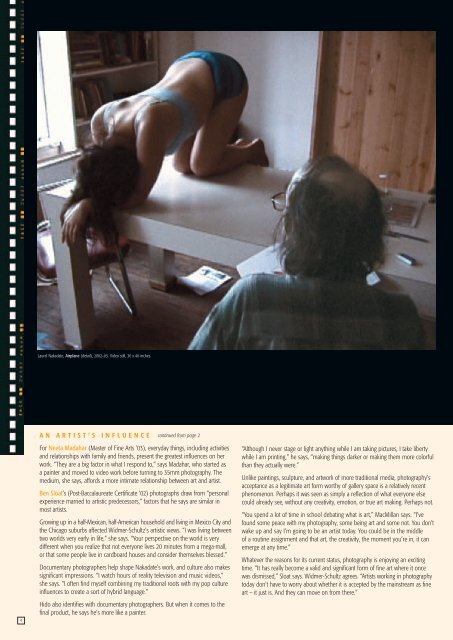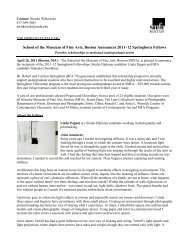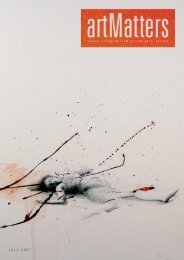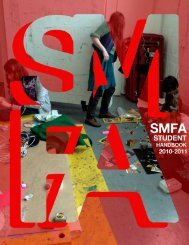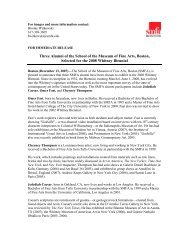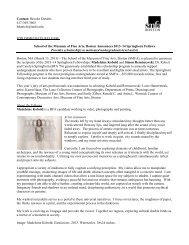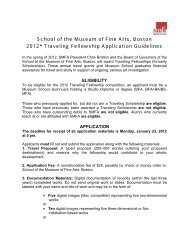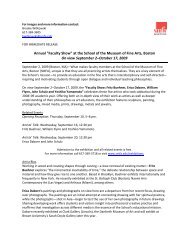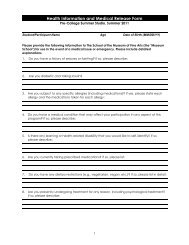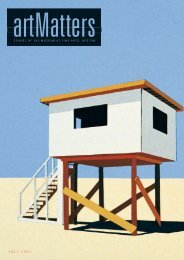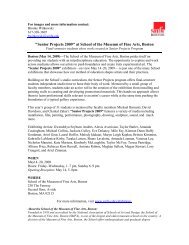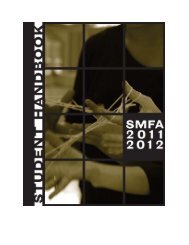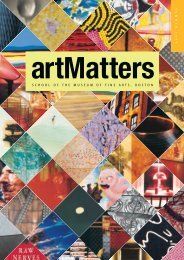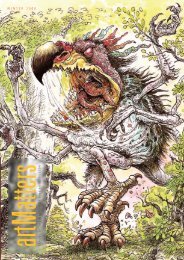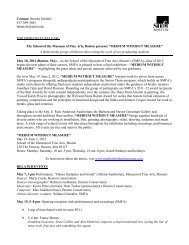S C H O O L O F T H E M U S E U M O F F I N E A R T S , B O S T O N
S C H O O L O F T H E M U S E U M O F F I N E A R T S , B O S T O N
S C H O O L O F T H E M U S E U M O F F I N E A R T S , B O S T O N
You also want an ePaper? Increase the reach of your titles
YUMPU automatically turns print PDFs into web optimized ePapers that Google loves.
Laurel Nakadate, Airplane (detail), 2002–03. Video still, 30 x 40 inches.<br />
AN ARTIST’S INFLUENCE<br />
continued from page 2<br />
4<br />
For Neeta Madahar (Master of Fine Arts ’03), everyday things, including activities<br />
and relationships with family and friends, present the greatest influences on her<br />
work. “They are a big factor in what I respond to,” says Madahar, who started as<br />
a painter and moved to video work before turning to 35mm photography. The<br />
medium, she says, affords a more intimate relationship between art and artist.<br />
Ben Sloat’s (Post-Baccalaureate Certificate ‘02) photographs draw from “personal<br />
experience married to artistic predecessors,” factors that he says are similar in<br />
most artists.<br />
Growing up in a half-Mexican, half-American household and living in Mexico City and<br />
the Chicago suburbs affected Widmer-Schultz’s artistic views. “I was living between<br />
two worlds very early in life,” she says. “Your perspective on the world is very<br />
different when you realize that not everyone lives 20 minutes from a mega-mall,<br />
or that some people live in cardboard houses and consider themselves blessed.”<br />
Documentary photographers help shape Nakadate’s work, and culture also makes<br />
significant impressions. “I watch hours of reality television and music videos,”<br />
she says. “I often find myself combining my traditional roots with my pop culture<br />
influences to create a sort of hybrid language.”<br />
Hido also identifies with documentary photographers. But when it comes to the<br />
final product, he says he’s more like a painter.<br />
“Although I never stage or light anything while I am taking pictures, I take liberty<br />
while I am printing,” he says, “making things darker or making them more colorful<br />
than they actually were.”<br />
Unlike paintings, sculpture, and artwork of more traditional media, photography’s<br />
acceptance as a legitimate art form worthy of gallery space is a relatively recent<br />
phenomenon. Perhaps it was seen as simply a reflection of what everyone else<br />
could already see, without any creativity, emotion, or true art making. Perhaps not.<br />
“You spend a lot of time in school debating what is art,” MacMillan says. “I’ve<br />
found some peace with my photography, some being art and some not. You don’t<br />
wake up and say I’m going to be an artist today. You could be in the middle<br />
of a routine assignment and that art, the creativity, the moment you’re in, it can<br />
emerge at any time.”<br />
Whatever the reasons for its current status, photography is enjoying an exciting<br />
time. “It has really become a valid and significant form of fine art where it once<br />
was dismissed,” Sloat says. Widmer-Schultz agrees. “Artists working in photography<br />
today don’t have to worry about whether it is accepted by the mainstream as fine<br />
art – it just is. And they can move on from there.”


